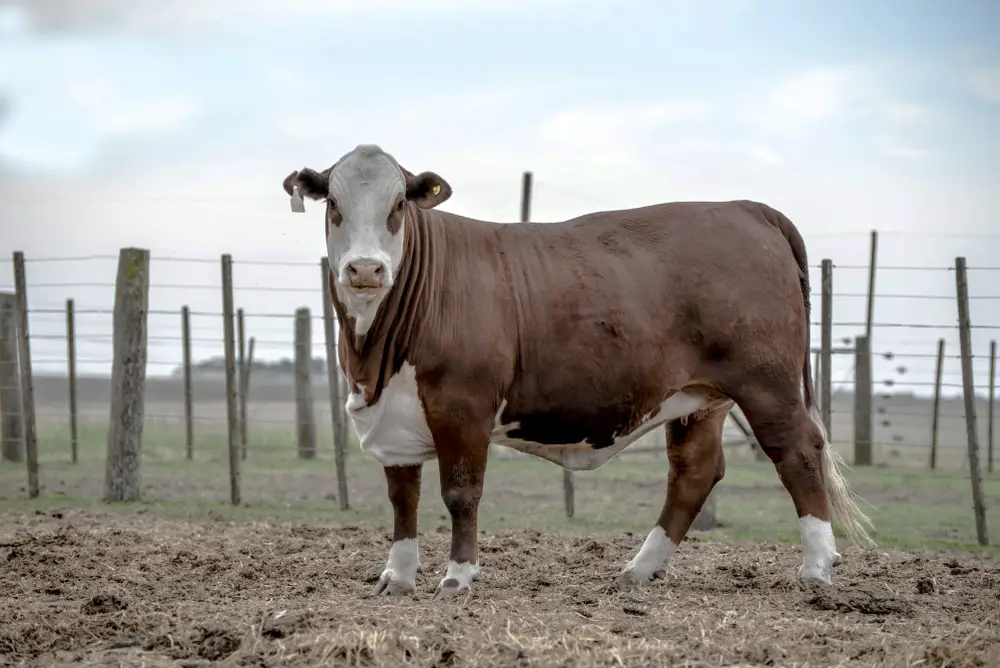Braford cattle are primarily used for meat production and sometimes you can find them on the rodeo circuit. The Braford is a cross between Brahman cows and Hereford bulls, making an excellent beef breed that resists most diseases and is heat-tolerant.
Today, over 25,000 herds can be found across the world, with the largest herds in Australia, South Africa, New Zealand, and the United States.
Table of Contents
Where Does The Braford Come From?
Two main types of Braford breed exist, the American Braford and the Australian Braford and they were each created independently of one another in the 1940s.
The American Braford
The American Braford is the result of a breeding program in Florida, conducted in 1947 by Alto Adams Jr who wanted to cross Hereford cattle with Brahman cattle. His breeding efforts were not initially successful until he found a herd of climatized calves that didn’t suffer from eye and foot problems to use as a base.
The resulting cross of a Hereford cow with a Brahman steer produced the foundational herd of the Braford breed in America.
Renowned for their hardiness, resistance to disease, and excellent mothering abilities, they were readily accepted and adopted by the cattle industry as a profitable production breed.
A purebred American Braford is 5/8 Hereford and 3/8 Brahman according to the United Braford Breeders.
The Australian Braford
A year before the American Braford was being created, the Australian Braford was undergoing breeding efforts in Rockhampton, Queensland in 1946 by the Rea brothers.
The Australian Braford differs from the American Braford, and is close to an F1 species, with roughly half Hereford blood, and half Brahman blood within a 5% margin.
Both American and Australian Brafords are highly sought after and have excellent genetics.
Brafords are known for high adaptability, virility and prolificacy, feed conversion, and carcass size.
Braford Breed Characteristics
| Official Breed Name | Braford Cattle |
| Scientific Name | Bos taurus |
| Origin | Australia and the United States |
| Appearance | Red with white belly, head, and feet. Has a hump, and droopy ears. |
| Calf Weight | 66 to 80lbs |
| Mature Cow Weight | 1200 to 1600lbs |
| Mature Bull Weight | 1900 to 2200lbs |
| Ready To Breed | 8 months |
| Gestation Period | 279 to 287 days |
| First Calvings | 22 to 24 months |
| Time to Slaughter | 6 to 9 months |
| Carcass Weight | Approximately 50% of liveweight |
| Expected Lifespan | 15 to 20 years |
| Productive Lifespan | 10-12 years |
| Known For | High adaptability, prolificacy, marbling of meat, and carcass quality |
| Weaknesses | Not known for docility, can be aggressive and does poorly in harsh winter weather |
| Climate | Does best in warm climates but can adapt to cool climates |

What Is So Special About Braford Cattle?
Cows have excellent mothering instincts with good fertility and easy calving. Productive longevity and optimal milk production makes the Braford cow highly desirable.
Excellent meat quality due to great foraging ability with low waste on carcasses also makes the Braford an excellent beef cattle breed to consider.
Why Should I Raise Braford Cattle On My Farm?
- Efficient breed that produces consistent beef quantity and quality
- Known for hardiness and resistant to most diseases and parasites lowering vet bills and minimizing herd loss
- Brafords are available in both polled and horned varieties depending on your needs
- Weaning of calves is done at roughly half the weight of the cow (440lbs to 585lbs)
- Hooded eyes make them unlikely to experience eye cancer or pinkeye infections
- Resistant to bloat through selective breeding
- Well-muscled carcass that has little waste
- Great feed conversion and conformation
- Heifers are drought resistant and will still produce healthy calves even with low quality grass
- Steers placed in the feedlot will gain roughly 4 pounds daily
- Braford bulls are known for being dominant, strong, and virile
- Small scale farmers will appreciate the Braford for adaptability and profitability
